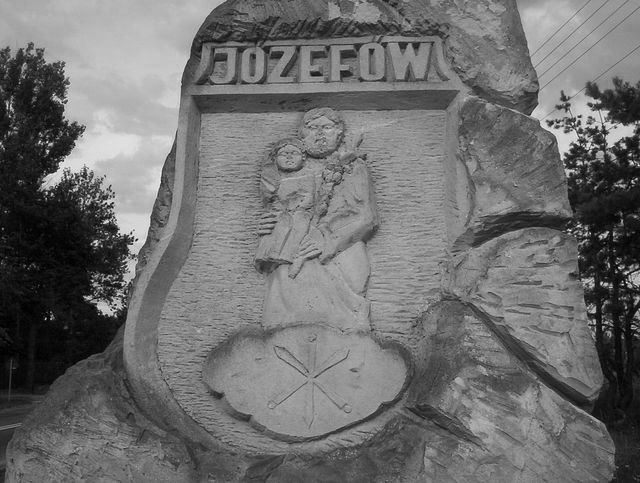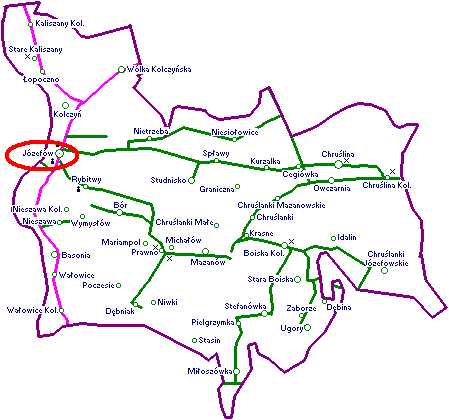Holocaust Education & Archive Research Team |
Ghettos
Introduction to the Ghettos of the Holocaust
Jewish Ghettos The Judenrat Judenrat Leaders Prominent Jews
| |||
Jozefow
Jozefow a small town was established in the first half of the 18th century, it was owned by the Zamoyski family. From its beginning Jozefow was a Polish- Jewish settlement, with the latter being in the majority.
Towards the end of the 18th century Christians resided on the outskirts and the central part of the town was wholly owned by Jews. The town had its own paper mill and a tool shop. At the beginning of the 19th century the paper mill was leased by the Wax family who were instrumental in making Jozefow an important centre for printing within the Jewish communities.
Half of the local inhabitants earned their living by printing and selling religious books in Hebrew. Many of the books were exported to other European countries and even to Turkey. However, a few decades later the printing house went bankrupt as it could not compete effectively with modern printing houses in Lublin, Warsaw and Vilnius. Equally detrimental was Russian censorship.
The headstones in the local Jewish cemeteries abound in book imagery, a testimony to the heyday of printing the town once enjoyed. During the Nazi occupation there were 1700 Jewish residents in Jozefow, and this number grew when 600 Jews from Konin were relocated there.
In September 1939 Jozefow was bombed by the German Luftwaffe, and a large part of the town centre was destroyed. At the end of September 1939 the Soviet Army entered Jozefow, but after a short occupation the Soviets left the town. Together with them, about 1,000 local Jews decided to escape to the Soviet Union. Only the poorest people stayed in the town. At the beginning of the occupation life went on for the local Jewish population without special atrocities by the Nazis. The symbol of the new era was the Judenrat, whose president was Baruch Goldsztajn. Among its members was the local pre-war rabbi Szymon Parzenczewski. The bad times in Jozefow started in March 1941.
On 18 March 1941 about 600 Jews were resettled from Konin (part of the territory included in the Warthegau). They were mainly very poor people who had lost their property - among them were a large number of old and sick people. This large number of resettled people soon became a major problem for the local Jews.
The new arrivals had to live together with the local inhabitants in overcrowded houses. Very soon food supply and hygienic conditions became the major problems. As one of the survivors described it: "Bread and potatoes were a luxury." Because of the extremely primitive living conditions, a typhus epidemic spread very quickly, especially among the Jews resettled from Konin. In 1941/1942 Jozefow was the centre of this epidemic in Bilgoraj County.
It is important to point out that there wasn’t a hospital nor a Jewish doctor in the village, only an "isolation house" which was too small for all sick people. Among the Konin Jews were two dentists, but without medical equipment.
"We are in a small town, destroyed because of the war, among very poor people who in fact need our help. We are living in very bad conditions. ...We feel mainly the lack of food, clothing and shoes, because we have lost everything." In the next letter to the same institution, M. Fürszt, the representative of Konin’s Jews, who worked in the people’s kitchen, wrote:
In August 1941 living conditions became even worse when several houses in which Jews lived were burned down at night. About 200 people lost the little property they had and were made homeless. At that time, according to a Judenrat report, 2,147 Jews lived in Jozefow. At the beginning of 1942, official rations for the Jews were 72 grams of bread a day and 200 grams of sugar a month. Sometimes they got 60 grams of soap and 1 litre of paraffin. The first Aktion in Jozefow, connected with “Aktion Reinhard”, took place on 1 May 1942. The Bilgoraj Gestapo arrived in the village with the local head of that institution, Columbus. Gestapo men arrested 20 Jews in the village who were on a special list.
They were accused of being Communists. In fact, throughout the county and in the neighbouring Zamosc County, the Gestapo and SS organised a wave of arrests of people who might potentially have been leaders of resistance when the deportations took place.
The Jews, arrested in Jozefow, were taken to the Gestapo prison in Bilgoraj and nobody knew what happened to them. It is possible that, together with other Jewish men from Bilgoraj and Tarnogrod, they were deported to Majdanek concentration camp.
From then on, not a month passed there without "murder" visits by the Germans. As well as the Bilgoraj Gestapo, the local Jews were afraid of members of the Schupo and the Bahnschutz-Polizei (railway security police) from a nearby railway station in the village of Dlugi Kat. Their commander, Werner, was responsible for the death of many Jews from Jozefow.
On 11 May 1942 three Gestapo or Schupo men (the organisation they belonged to is not clear) organised a special Aktion in Jozefow. They shot about 130 Jews on the streets and in the local quarry. This first massacre in the village was so horrible that it deeply shocked even the Germans in the civil occupation administration.
The largest single massacre, but not the final liquidation of the entire Jewish population, happened on 13 July 1942. On that day men of the 101st Reserve Police Battalion, commanded by Major Trapp, executed 1,300 - 1,500 Jews in Jozefow. These people were taken from their homes and gathered at the market square. There a selection was held - about 300 young men were taken to the railway station and deported by train to Lublin, probably to the Airfield Camp.
The other people, after a short journey in trucks, were shot in the forest about 2 km from the village. The execution took place on both sides of the road to Bilgoraj, at a site which the local inhabitants called Winiarczykowa Gora (Winiarczykowa Hill). Many people were already killed in Jozefow itself - in their homes or on the streets. Some policemen stated after the war during their trial:
"The bodies of the shot Jews were everywhere - on the streets, in the houses and at the marketplace."
“When the first truckload of thirty-five to forty Jews arrived, an equal number of policemen came forward and face to face were paired off with their victims. Led by Kammer, the policemen and Jews marched down the forest path. They turned off into the woods at a point indicated by Captain Wohlauf who busied himself throughout the day selecting the execution sites. Kammer then ordered the Jews to lie down in a row. The policemen stepped up behind them, placed their bayonets on the backbone above the shoulder blades as earlier instructed, and on Kammer’s orders fired in unison.”
By the evening the massacre was finished. The policemen went back to Bilgoraj, but not all the Jews had been killed. Some of them still hid in cellars or in the forest. Some, who were only wounded, came back from the execution site - no mass graves had been dug, but after the execution the local Polish population was given the task of burying the bodies.
We may suppose that about 200-300 Jews survived the execution, which very quickly became known in the surrounding towns and villages. As well as those who survived the massacre, new Jews soon arrived in Jozefow. They were from nearby villages and had to move to Jozefow, where, according to an SS order, all Jews from the surrounding localities had to be collected.
This group probably numbered nearly 300-400 people. Among them was Estera Fefer from Krakow, resettled from there in 1940 to Lukowa, a village near Jozefow. She survived, and after the war she wrote in her testimony: "Jozefow was a town of death. The people were killed without an “Aktion”, for no reason. At Yom Kippur they (the Germans) took people according to a list of names. Officially there were 20 names on the list, but they took 70 people. They were taken to the fire station where they were beaten horribly, and then they were shot in the quarry behind the town, near the forest. During this “Aktion” the local Polish population was very helpful." This group of people was shot because Columbus, chief of the Bilgoraj Gestapo, ordered a high contribution to be gathered from the Jews in Jozefow. Because the local Judenrat did not give him the money in time, these 70 Jews were killed as hostages. This happened in September 1942.
All Jews who did not escape to the forest were gathered in the fire station, and then had to walk to the railway station in Dlugi Kat. On the way, many of them were shot - their mass grave is located at Chojniasta Gora (Chojniasta Hill). Others were deported from Dlugi Kat to the Belzec death camp. The group probably numbered about 200 - 300 people. These were the last deportations to Belzec from Bilgoraj County.
At this time some of the Jews from Jozefow escaped to the forests. Throughout November and December 1942 the “Schutzpolizei” and “Bahnschutz-Polizei” organised round-ups around Jozefow, looking for hidden Jews. Those they caught were locked up in the village jail. Always when a group of 10 - 15 people was collected they were executed near the new school building in Jozefow. Some of the Jews in the forests became victims of bands, organised by local farmers who wanted to rob these unarmed Jews.
Some more major struggles took place in June 1944, under participation of armed Jews. Finally, in July 1944, the Soviet Army entered the region and a small group of survivors was liberated, including Estera Fefer with her family.
Today it is difficult to say how many Jews from Jozefow survived. The total number of Jewish victims can be estimated at approximately 2,500 - 2,600 people. Today only one Jewish survivor who converted to Catholicism after the war lives in Jozefow.
Jozefow's 18th century synagogue in the town centre is now a public library and a picturesque Jewish cemetery can be seen today. At the site of the "13 July Massacre" a memorial stone was put up.
Lublin State Archives: Collection of documents, gathered by Dr. Zygmunt Klukowski of Szczebrzeszyn, 1944-1946. Archives of the Jewish Historical Institute in Warsaw: Documents of Jüdische Soziale Selbsthilfe; Testimony by Holocaust Survivors - Testimony by Estera Fefer. Dziennik z lat okupacji (Diary of the Occupation Years), by Z. Klukowski, Lublin 1959. Ordinary Men- The 101st Reserve Police Battalion and Final Solution in Poland, by Christopher R. Browning, published by Harpers Collins 1992. From Lublin to Belzec, by Robert Kuwalek, published by AD REM 2006
Copyright Robert Kuwalek and Chris Webb. H.E.A.R.T 2007
|





